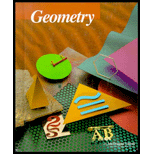
a.
To state the position of symmetry points.
a.
Answer to Problem 25WE
The symmetry points are at the middle points of the sides of quadrilateral.
Explanation of Solution
Given information:
The tessellation has many symmetry points but not at the vertices of quadrilateral.
The symmetry points are at the middle points of the sides of quadrilateral. It can be better understand by taking any two adjacent quadrilateral and taking middle point of the common side of the two quadrilateral as the point of symmetry you will observe that after each half turn the figure maps onto itself.
b.
To state the type of symmetry of the mosaic.
b.
Answer to Problem 25WE
The mosaic has translational symmetry.
Explanation of Solution
Given information:
The given mosaic has symmetry.
The mosaic has translational symmetry.In the mosaic the quadrilaterals are congruent but placed in two different orientation and each quadrilateral repeats after a fixed distance both vertically and horizontally. Hence, the mosaic has translational symmetry.
Chapter 14 Solutions
McDougal Littell Jurgensen Geometry: Student Edition Geometry
Additional Math Textbook Solutions
A First Course in Probability (10th Edition)
A Problem Solving Approach To Mathematics For Elementary School Teachers (13th Edition)
University Calculus: Early Transcendentals (4th Edition)
Thinking Mathematically (6th Edition)
Elementary Statistics: Picturing the World (7th Edition)
Algebra and Trigonometry (6th Edition)
- Mariela is in her classroom and looking out of a window at a tree, which is 20 feet away. Mariela’s line of sight to the top of the tree creates a 42° angle of elevation, and her line of sight to the base of the tree creates a 31° angle of depression. What is the height of the tree, rounded to the nearest foot? Be sure to show your work to explain how you got your answer.arrow_forward1arrow_forward20arrow_forward
 Elementary Geometry For College Students, 7eGeometryISBN:9781337614085Author:Alexander, Daniel C.; Koeberlein, Geralyn M.Publisher:Cengage,
Elementary Geometry For College Students, 7eGeometryISBN:9781337614085Author:Alexander, Daniel C.; Koeberlein, Geralyn M.Publisher:Cengage, Elementary Geometry for College StudentsGeometryISBN:9781285195698Author:Daniel C. Alexander, Geralyn M. KoeberleinPublisher:Cengage Learning
Elementary Geometry for College StudentsGeometryISBN:9781285195698Author:Daniel C. Alexander, Geralyn M. KoeberleinPublisher:Cengage Learning

